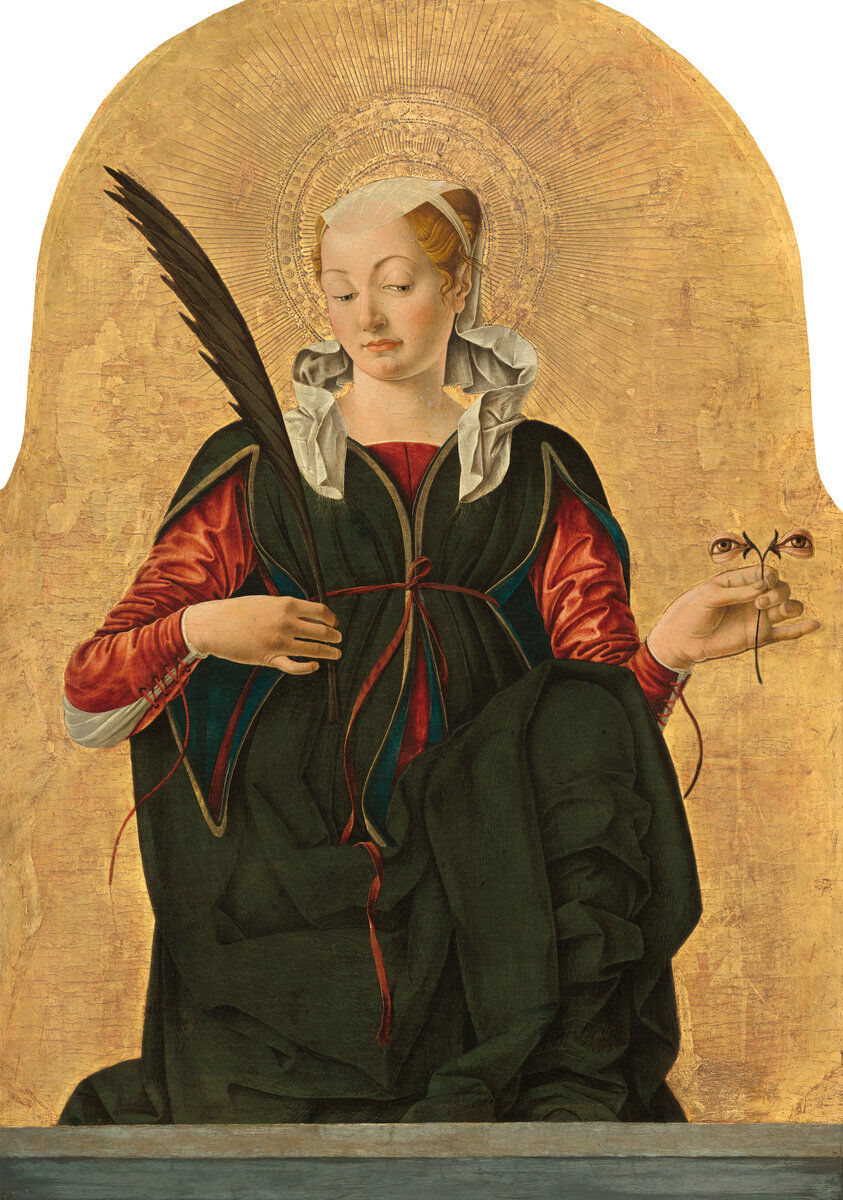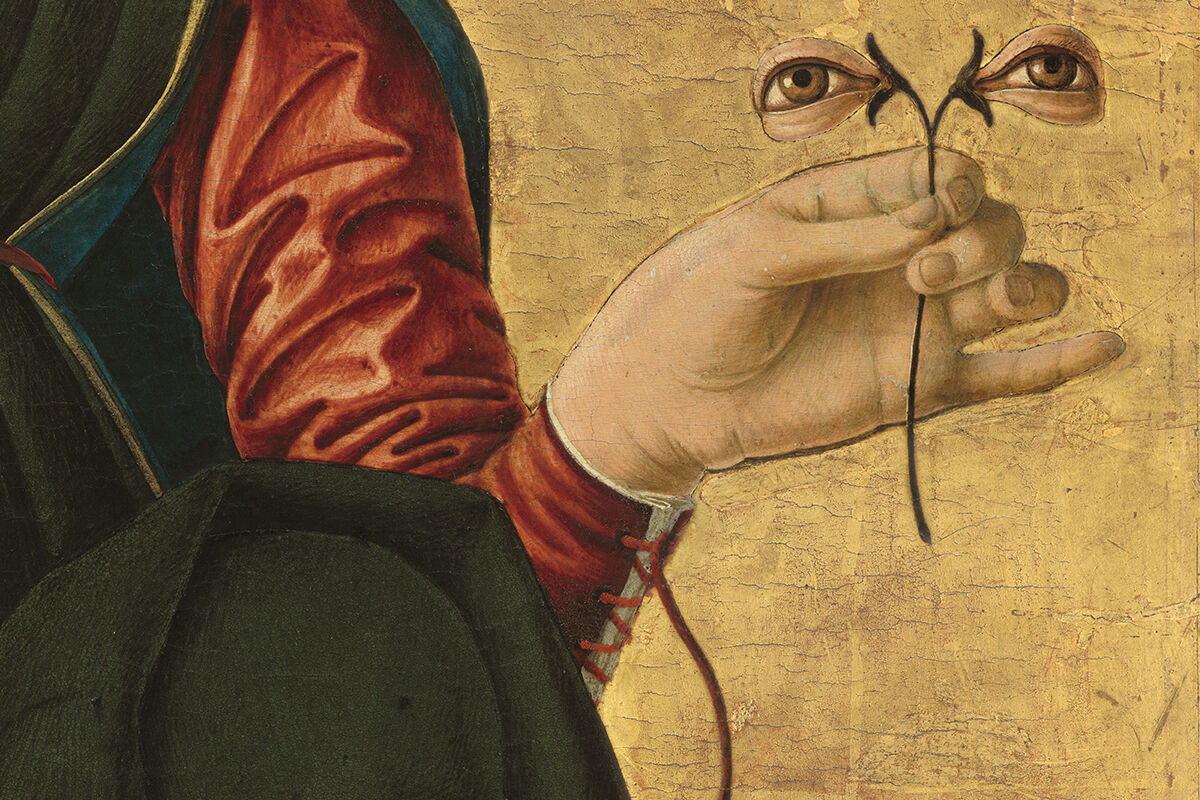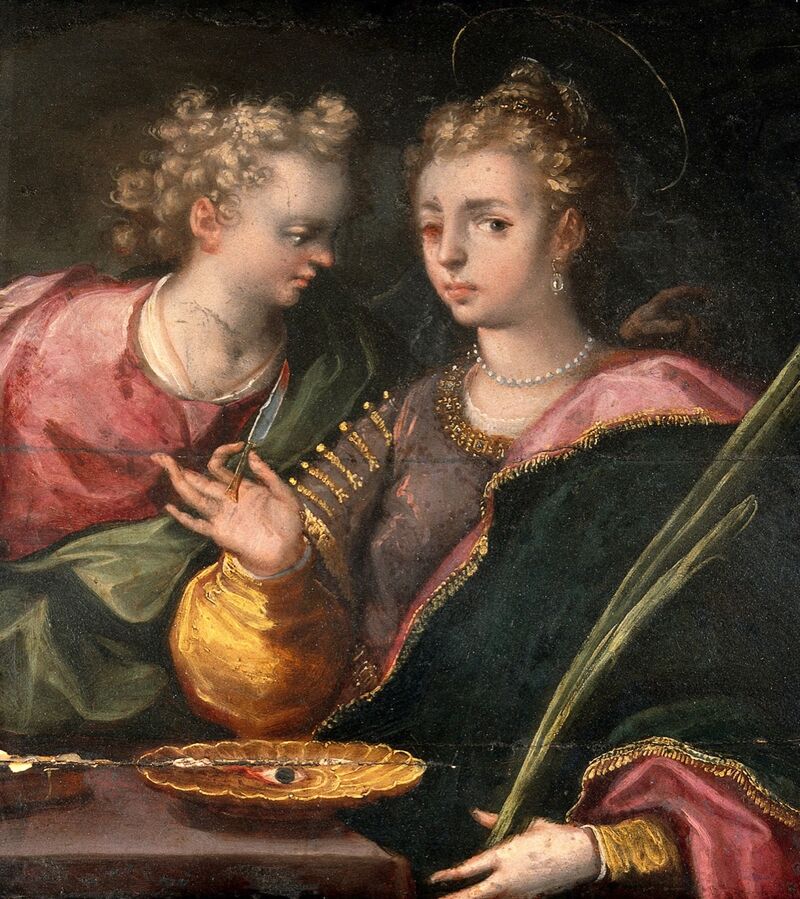 Art
Art
I’m Obsessed with Saint Lucy’s Extra Set of Eyes in This Renaissance Painting
Alexxa Gotthardt, Jan 15, 2020 6:52pm
Disembodied eyes are a gruesome, mesmerizing thing. As a kid in the ’90s, I associated them with shows like Goosebumps, where weird, gelatinous mutants plucked their own eyeballs from the comfort of their heads. Later, when the art-history nerd in me surfaced, I recognized their home in
, where
nestled a single eye in a slice of fatty ham in The Portrait (1935), and
rendered two egg-shaped baby blues on a floating slab of wood in Ojos Sobre la Mesa (1935).A simply laid-out meal is not as simple as it seems. Each object is rendered with equally sharp focus and pictorial realism, yet any expectation of everyday reality is overturned, above all by the unblinking eye that stares inexplicably from a slice of ham on a plate. The perspective of this still life tilts dramatically toward the surface of the picture plane, as if to confront or perhaps invite the viewer to join the table.
, where
nestled a single eye in a slice of fatty ham in The Portrait (1935), and
rendered two egg-shaped baby blues on a floating slab of wood in Ojos Sobre la Mesa (1935).A simply laid-out meal is not as simple as it seems. Each object is rendered with equally sharp focus and pictorial realism, yet any expectation of everyday reality is overturned, above all by the unblinking eye that stares inexplicably from a slice of ham on a plate. The perspective of this still life tilts dramatically toward the surface of the picture plane, as if to confront or perhaps invite the viewer to join the table.
Gallery label from Magritte: The Mystery of the Ordinary,1926–1938
Paintings like these always made me acutely aware of the softer, gooier parts of my body and occasionally triggered freaky dreams about sightlessness—an especially scary affliction when you desperately love art and find extreme joy in looking closely at the world. But they also enthralled me, and recently, when I stumbled across a bizarre detail in
’s Italian Renaissance altarpiece panel Saint Lucy (ca. 1473–74), an obsession bloomed.
’s Italian Renaissance altarpiece panel Saint Lucy (ca. 1473–74), an obsession bloomed.

Francesco del Cossa, Saint Lucy , c. 1473/1474. Courtesy of the National Gallery of Art.
In many ways, Saint Lucy struck me as a typical Italian Renaissance picture. Rounded corners suggest it was tucked into a Catholic altar; a sumptuous gilded background points to filthy-rich patrons; and the subject’s luscious, flowing robes radiate the mid-Renaissance taste for naturalism laced with sensuality. Lucy’s piercing side-eye surprised me, though. So did the object of her gaze: a delicate stem from which two disembodied eyeballs, rather than flower buds, spring.Saint Lucy’s extra set of eyes didn’t square with my limited knowledge of Renaissance iconography and Catholic lore, nor with my previous run-ins with floating eyes. I would have expected them to crop up in a chimera-inspired Surrealist picture or at the climax of a pulp horror flick, but not ensconced in 15th-century gold leaf and cradled in the fingers of a Christian saint. I didn’t know anything about the tortures Saint Lucy faced at the hands of jealous, possessive men—or her grisly fate.
Saint Lucy
View Slideshow
3 Images

As it turns out, paintings of Saint Lucy carrying eyeballs, standing next to eyeballs, or offering up plates of eyeballs emerge countless times across Renaissance art. According to historians, they were most popular in Italy, but examples also emerged in Spain, Peru, and other majority-Catholic countries thanks to a medieval addition to Saint Lucy’s macabre origin story.
Many versions of the legend exist, but most accounts agree that Lucy was born in Syracuse, Sicily, around 283 C.E. to an aristocratic family and was martyred circa 304 C.E. by the Roman emperor Diocletian because of her allegiance to a Christian god. Supposedly, she also vowed to remain chaste and, going against her family’s wishes, refused to marry a pagan.
The accounts of the torture that Lucy endured range widely. Some describe attempted punishment involving a fiery stake, imprisonment in a brothel, and rape. In The Golden Legend, a popular medieval chronicle of the lives of saints, her sentencer Paschasius, the Governor of Sicily, cries: “Then I shall send thee to a house of ill fame! There thy body will be violated.” Lucy’s retort smacks with pure courage: “The body is not soiled unless the soul consents.…Why delayest thou? Son of the devil, begin! Carry out thy heinous design!”
Likely inspired by Lucy’s name, which derives from lux, or “light,” later versions of the tale add the gouging of her eyes to her long list of abuses. Some say she did the deed herself, in order to avoid the hungry male gaze and put off her pagan husband-to-be; others describe Diocletian committing the act. In both, God restores Lucy’s vision—but Diocletian eventually prevails with a sword to her throat (this denouement is the focus of most Northern European depictions of the saint).
Perhaps inspired by Italian Renaissance artists’ flair for the dramatic, Lucy’s gouged eyes and miraculous recovery became a favorite motif. Most often, she’s shown proffering her detached eyes on a plate, as in Francisco de Zurbarán’s 17th-century Saint Lucy (ca. 1625–30). She’s also been presented poising them proudly between two fingers, as in Francesco Zaganelli’s depiction, circa 1500, or in the gory process of extracting them, like one rarified 16th-century Italian canvas.
Cossa’s version, though, remains my favorite for its bizarre floral treatment of disembodied eyes and their bearer’s fiery persona. Lucy is pictured with arched eyebrows, pursed lips, and a penetrating glare. In 1934, Italian art historian Roberto Longhi hypothesized that the painting was part of a double altarpiece commissioned by Floriano Griffoni; the patron’s wife was named Lucia. Longhi also noted that Cossa’s depiction of eyeballs as flowers was derived from the name Floriano. While this, like many mysteries surrounding the painting, still isn’t confirmed, it’s clear that this Saint Lucy exudes a hot-blooded humanity absent in creepier, surrealistic depictions of detached eyes, where female bodies are disassociated and dismembered. Here, she is in control of her form—presenting her eyes (along with her vision, and maybe even viewpoint) as elements to be revered and honored, rather than picked apart.
Alexxa Gotthardt is a contributing writer for Artsy.

